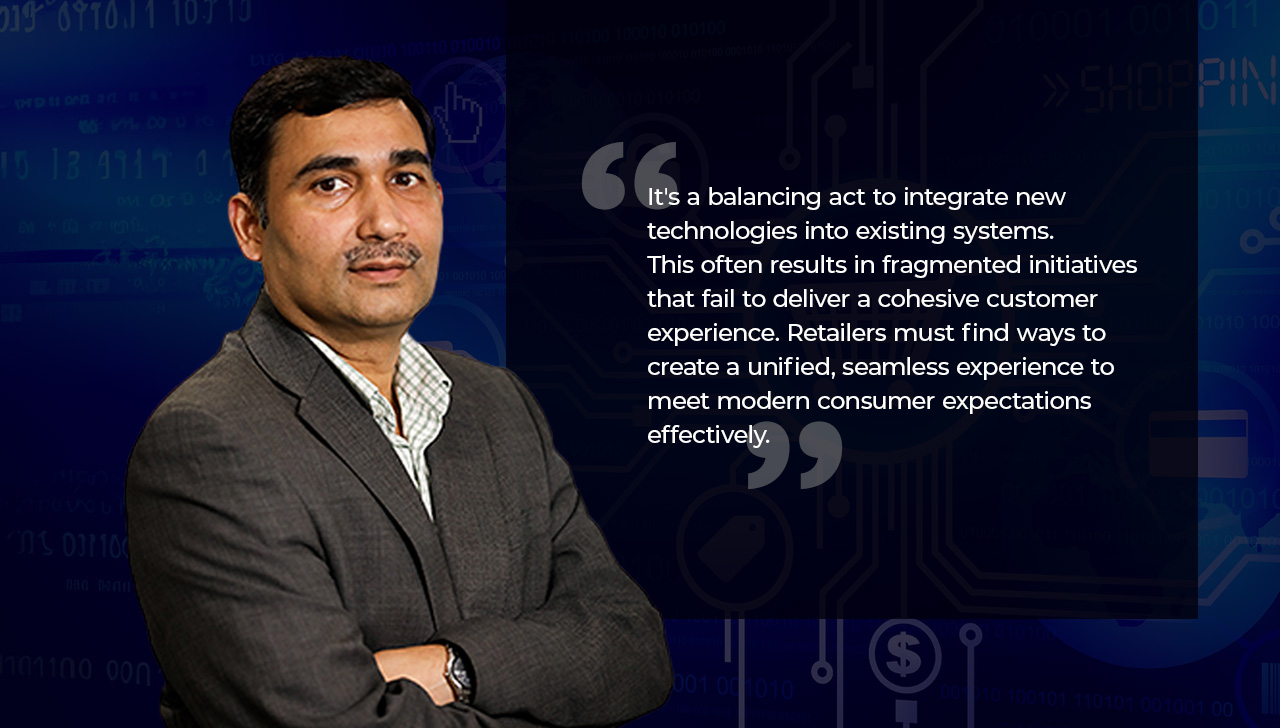‘Data and AI are game changers for front-end retail technologies’
By Retail4Growth Bureau | July 01, 2024
In this exclusive column for Retail4Growth, Abhijit Niyogi, VP & Business Unit Head – Retail, TCS, shares his insights on the trends shaping Indian retail industry and how retailers can effectively leverage technology for better business results.

As India accelerates towards becoming the third-largest retail market in the world, 2024 is further poised to be a transformative year for the industry. Driven by rising disposable incomes, rapid urbanisation, a burgeoning middle class, and an increasingly digitally-savvy consumer base, the Indian retail sector offers a promising investment landscape for both domestic and global entities.
The retail market, this year, is set to witness a significant influx of international brands and foreign investments entering India and reshaping the country’s retail landscape. The demand from a new generation of shoppers for upscale brands is driving international retailers to actively seek partnerships and establish their presence in India. Additionally, the organised retail sector is expected to grow substantially here, with its market share projected to increase from 12% in FY 2021 to an estimated 20% in FY 2025. The luxury market is also on the rise, propelled by an increasing number of high-net-worth individuals (HNWI), the emergence of non-metro areas as luxury consumption hubs, and the growing popularity of luxury products.
Rise of Tier-1 & Tier-2 cities
Smaller cities are taking the lead in the Indian retail success story in a post-pandemic world. In fact, the next phase of growth in the retail sector will be driven by Tier-2 and Tier-3 cities as they witness a surge in demand for both physical stores and online shopping experiences. The increased purchasing power and a growing appetite for quality products, particularly among younger generations, are pushing retailers to expand beyond major cities. The franchise sector is also booming in these regions as established brands seek to capitalise on the growing market, explore new concepts and expand their reach. Overall projections indicate that by 2025, the Indian franchise industry will surpass US$845.09 million. What is adding to the momentum is that online shopping is gaining traction in smaller cities, with most buyers coming from Tier-2 and Tier-3 cities.
Innovating with tech
India's retail sector is also undergoing a technological revolution, with brands increasingly adopting technology to enhance in-store experiences. Innovations such as smart trolleys and electronic shelf labels are being introduced to make shopping more convenient. This drive for innovation extends to online shopping as well, where advanced checkout solutions are being created to reduce frictions; these include AI chatbots, QR codes for contactless payments, and biometric security measures. The retailers are also embracing augmented reality (AR), virtual reality (VR), and mixed reality (MR) to create immersive experiences. These technologies are especially appealing to Gen-Z and millennial consumers who prioritise experiential spending. This is evident in the case of Titan Eye+’s interactive advertisement, which features a virtual image of prominent Bollywood personality, engaging shoppers with style advice and interactive experiences. This year, we can expect to see more such consumer-facing, novel, and convenient technology solutions roll out and light up the shopping scene.
Game changers for front-end retail technologies
In terms of front-end retail technologies, data and AI are game changers, solving critical aspects of customer experience, discoverability, and customer assistance. By leveraging advanced data analytics and AI, retailers can gain deeper insights into consumer behavior, preferences, and trends, enabling personalized shopping experiences. These technologies also enhance discoverability and footfall by offering targeted recommendations and promotions, ultimately increasing face time with customers, and driving higher engagement in stores. A unified commerce strategy is essential, and at TCS, we are investing in TCS OmniStore™, a groundbreaking piece of front-end technology. This AI-powered composable commerce platform helps retailers drive a unified, frictionless, and personalized customer experience across all touchpoints. Additionally, continuous innovation is crucial for maintaining a competitive edge. By fostering a culture of experimentation and adopting cutting-edge technologies, retailers can differentiate their propositions and achieve a significant competitive advantage in the rapidly evolving retail landscape.
Generative AI adoption set to surge
Generative AI is in fact poised to become a core component of the Indian retail business strategy in 2024. According to TCS’ AI for Business Study, The vast majority of Retailers surveyed (93%) have AI implementations planned, in process or already completed. Hyperpersonalised recommendations, virtual product trials, and seamless product discovery are just a few examples of how generative AI will enhance the shopping experience. Its impact on business operations is equally significant, aiding in inventory management, demand forecasting, and supply chain management. The retail industry is at a pivotal moment to intensify generative AI adoption, making it crucial for retailers to act now and capitalise on the transformative power of this technology, or risk falling behind their competitors.
Key pain points for retailers in adopting front-end technologies
Retailers however do face some pain points when it comes to adopting front-end technologies, starting with the high cost of implementation. Advanced technologies like AI, AR, and VR require significant investment in infrastructure, software, and skilled personnel. For many retailers, especially small and medium-sized ones, these costs can be prohibitive, limiting their ability to compete with larger competitors. Additionally, many retailers struggle with a disjointed strategy. It's a balancing act to integrate new technologies into existing systems. This often results in fragmented initiatives that fail to deliver a cohesive customer experience. An unconnected experience across different channels—online, in-store, and mobile—further exacerbates the issue, leading to customer dissatisfaction and lost sales. Retailers must find ways to create a unified, seamless experience to meet modern consumer expectations effectively. TCS algorithmic retail along with algo scan helps provide concise and forward-looking strategy navigating business and tech for retailers.
Super apps to take centrestage
The growing demand for one-stop solutions among Indian consumers and the potential of the digital commerce sector will also have conglomerates and e-retailers vying for dominance in the super apps space in 2024. These all-in-one platforms simplify processes, improve customer engagement, and increase revenue opportunities by allowing users to make payments, book travel, order food, and access other services all within one platform. To maintain a competitive edge, super app players will increasingly collaborate with digital start-ups, service providers, and local vendors. Retailers must carefully evaluate these opportunities and build their presence in this competitive market strategically to optimise their services.
Hyperlocal commerce and 15-minute delivery
India’s retail sector is experiencing a surge in online shopping, driven by a combination of factors including post-pandemic consumer spending and the rise of e-commerce. The contemporary Indian consumer is expected to significantly increase e-commerce subscriptions, emphasising convenience, especially in rural areas. The rise of direct-to-consumer brands and quick commerce services, offering lightning-fast delivery to urban and rural areas, highlights the ongoing trend towards online shopping. In 2024, this shift, combined with AI advancements and India’s thriving start-up ecosystem, will drive new last-mile delivery models focused on cost-efficiency, hyperlocal commerce, and rapid delivery times, with some services promising doorstep delivery in as little as 15 minutes. This not only revolutionises last-mile delivery models, but also creates new opportunities for businesses.
As India’s retail sector embarks on this exciting journey, driven by dynamic consumer demand and the adoption of new technologies, it’s clear that adaptability, innovation, and a focus on the customer will be essential for success. In doing so, the retailers who embrace these trends will be well-positioned to capitalise on the immense growth potential of the Indian market.


_165_265.jpg)
_165_265.jpg)
_140_270.jpg)




Comments